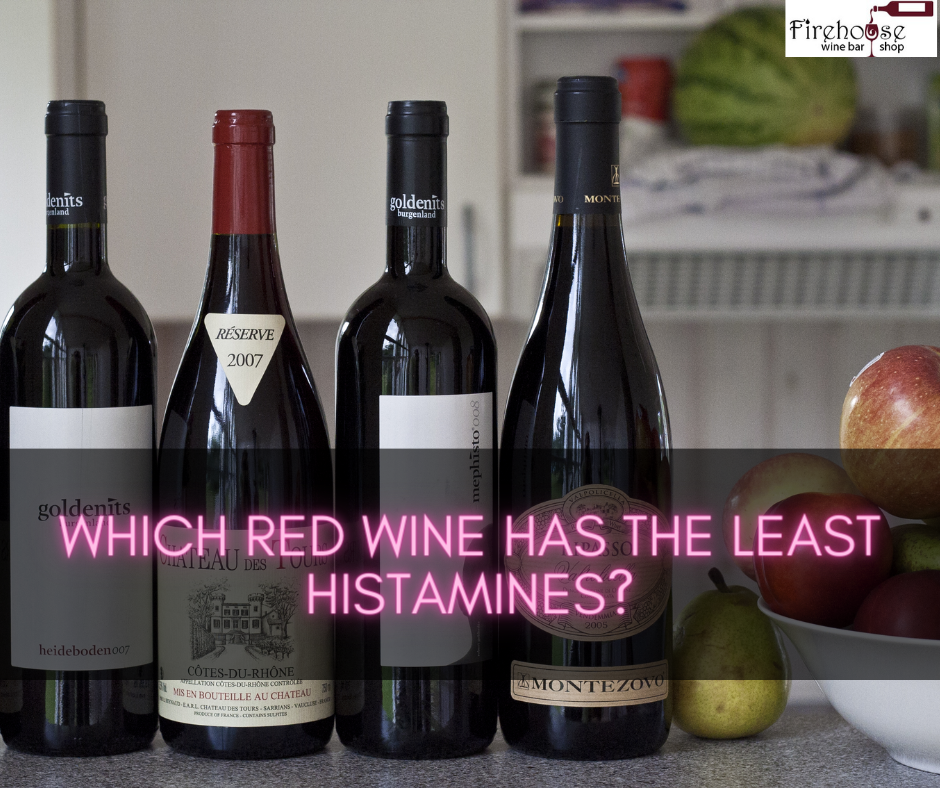Understanding The Impact Of Histamines In Red Wine
Histamines in red wine can cause allergic-like symptoms in some individuals, such as headaches, nasal congestion, and difficulty concentrating. These symptoms can be particularly bothersome for people with histamine intolerance. Histamine levels in wine can vary depending on factors such as grape variety, fermentation processes, and aging. While all types of wine can contain histamines, red wines have higher concentrations than white wines, sparkling wines, and rosés. Red wines can have 20-200% more histamines than white wines.
A study comparing 52 wines and 17 beers found that red wine had significantly higher histamine levels than white wine, champagne, and beer. This correlation between histamine levels and reactions to wine has been observed in numerous studies. Histamine levels can vary even within red wines of different grape varieties, and high-quality wines have been shown to contain substantial amounts of histamines.
So, Which Red Wine Has the Least Histamines? This blog will help you to answer this question.

The Importance Of Selecting Low-histamine Red Wine Options
For individuals with histamine intolerance or those who want to reduce their histamine intake, selecting low-histamine red wine options can significantly affect their wine-drinking experience. While it is not possible to completely remove histamines from wine, some types of red wines have been found to have lower levels of histamines compared to others.
Pinot Noir is often recommended as a red wine with lower histamine levels, although this finding is inconclusive. Other red wine options that may be lower in histamines include Barbera, Bonarda, Cabernet Franc, Carmenere, Grenache, Merlot, and Montepulciano. It is important to note that histamine levels can still vary within the same grape variety, depending on winemaking processes and aging.
Choosing younger wines over those aged for longer periods is advisable when looking for low-histamine red wines. Younger wines generally have lower histamine levels. Additionally, selecting wines from wineries that use special bacterial strains during the fermentation process to lower histamine levels can be beneficial.
It is essential to seek professional advice from an allergist or doctor if you have histamine intolerance or other allergies. They can provide personalized recommendations and guide you in choosing the best low-histamine red wine options based on your needs and health conditions.
Overall, selecting low-histamine red wine options can help individuals with histamine intolerance enjoy a glass of wine without experiencing unpleasant symptoms. It is worth exploring different grape varieties and winemaking processes to find the most suitable options for your palate and health.
Histamine Levels In Different Types Of Red Wine
When enjoying a glass of red wine, some individuals may experience adverse reactions due to histamine sensitivity. Histamines are naturally occurring compounds in wine that can cause allergy-like symptoms such as headaches, nasal congestion, and rashes. However, not all red wines are created equal regarding histamine levels. In this section, we will examine the variations in histamine levels among different red wine varieties and provide you with low-histamine options without worrying about potential reactions.
Highlighting The Impact Of Fermentation Processes On Histamine Content
Histamine levels in red wine can vary due to several factors, including grape variety, fermentation methods, and aging processes. During the fermentation process, the interaction between the yeast and grape components can lead to the formation of histamines. Wines that undergo extended fermentation or are made with overripe or damaged grapes often have higher histamine levels. Additionally, wines aged in oak barrels can have higher histamine content than those aged in stainless steel tanks.
Now, let’s look at some red wine varieties with lower histamine levels that can be suitable options for individuals with histamine sensitivity.
1. Pinot Noir: Pinot Noir is often regarded as one of the red wine varieties with the lowest histamine levels. It is produced from grapes that have thinner skins, resulting in lower histamine content. This elegant and versatile wine offers a delicate flavor profile with notes of red fruits and earthiness.
2. Merlot: Merlot is another red wine variety known for its lower histamine levels. This medium-bodied wine is prized for its smoothness and approachability, with flavors of ripe plums, black cherries, and hints of herbs.
3. Cabernet Sauvignon: Although Cabernet Sauvignon can have slightly higher histamine levels than Pinot Noir and Merlot, it is still considered a relatively low-histamine option. This full-bodied wine offers bold black currants, dark chocolate, and spices flavors, making it a favorite among red wine enthusiasts.
Please note that individual tolerance to histamines may vary, and it is always advisable to consult with a healthcare professional if you have histamine sensitivity or any specific concerns.
In conclusion, if you experience histamine sensitivity and still wish to indulge in red wine, there are several options with lower histamine levels to consider. Pinot Noir, Merlot, and Cabernet Sauvignon are generally recognized as red wine varieties that may be more suitable for individuals with histamine sensitivity. However, it’s essential to remember that everyone’s tolerance levels can differ, so it’s best to listen to your body and find the red wine that works best for you.

Pinot Noir: A Low-histamine Red Wine Option
Pinot Noir is a promising choice if you find ‘Which Red Wine Has the Least Histamines?’. While there is no definitive way to test for histamine levels in wine, some research suggests that Pinot Noir wines may have lower histamine levels than other red wines. However, it’s important to note that these findings are inconclusive and should not replace professional advice from an allergist or doctor. Consulting your healthcare provider is essential before changing your diet or drinking habits.
Exploring The Histamine Levels In Pinot Noir Compared To Other Red Wines
Histamines in red wine can cause allergic-like symptoms in some individuals, such as fogginess, stuffiness, and difficulty concentrating. While all types of wine can contain histamines, certain factors can affect the histamine levels present in a bottle. Research suggests that older wines and wines produced through certain fermentation processes may have higher levels of histamines.
When it comes to low-histamine options, Pinot Noir and Merlot are often recommended. Pinot Noir, in particular, has been found to have lower levels of histamines potentially. However, it’s important to remember that histamine levels vary among different bottles and winemaking techniques.
The Characteristics And Flavor Profile Of Pinot Noir
Besides its potential low histamine content, Pinot Noir is known for its distinct characteristics and flavor profile. This light-bodied red wine typically exhibits delicate flavors of cherry and raspberry, making it an easy-to-drink option for many wine enthusiasts. Its versatility allows it to pair well with various foods, such as steak and mushrooms, or it can be enjoyed on its own. The refreshing and nuanced qualities of Pinot Noir make it a popular choice among those looking for a low-histamine red wine option.
While Pinot Noir shows promise as a low-histamine red wine, it’s important to remember that individual reactions to histamines may vary. If you have histamine intolerance or allergies, it’s advisable to start with small amounts and monitor your body’s response. Additionally, exploring other low-histamine red wine options and consulting with a healthcare professional can help you make the best decision for your needs.
Which Red Wine Has The Least Histamines? – Selecting Low-histamine Red Wine Options
If you suffer from histamine intolerance and love a good red wine, you may wonder, ‘Which Red Wine Has the Least Histamines?’. Histamines in red wine can trigger allergic-like symptoms in many individuals, but the good news is that low-histamine red wine options are available.
Merlot: Another Low-histamine Red Wine Choice
One red wine variety known for having lower histamine levels is Merlot. This wine has a milder flavor than other red wines, making it easy to drink and enjoy. Merlot is a light-bodied wine with delicate flavors of plum and blackberry, and it pairs well with hearty foods like steak and mushrooms.
Comparing The Histamine Levels In Merlot To Other Red Wines
To better understand the histamine levels in Merlot, let’s compare it to other red wines. It’s important to note that histamine levels can vary depending on the winemaking process and grape variety, so these numbers are general estimates:
| Red Wine Variety | Histamine Levels |
|---|---|
| Merlot | Low |
| Cabernet Sauvignon | Medium |
| Syrah/Shiraz | Medium |
| Pinot Noir | Low to Medium |
Comparing these red wine varieties, Merlot stands out as a low-histamine option, making it a great choice for individuals with histamine intolerance.
Discussing The Taste And Aroma Of Merlot
In addition to its lower histamine levels, Merlot offers a pleasant taste and aroma profile. The wine has ripe plum, blackberry, and sometimes even cherry flavors. It has a smooth and velvety texture with a medium body that is easy on the palate.
The aroma of Merlot typically includes notes of red fruits, such as raspberry and strawberry, along with hints of earthiness and spice. This combination of flavors and aromas makes Merlot an enjoyable and versatile red wine option.
In conclusion, if you’re looking for a red wine with the least histamines, Merlot is a great choice. Its lower histamine levels, delicious taste, and aroma make it a favorable option for individuals with histamine intolerance. Always consult your healthcare provider for any concerns or specific allergies.
Other Low-histamine Red Wine Varieties
For those sensitive to histamines and wanting to enjoy a glass of red wine without the unpleasant side effects, other options with lower histamine levels are available. While Pinot Noir and Merlot are popular choices, additional red wine varieties may be suitable for individuals with histamine intolerance.
Exploring Additional Red Wine Options With Lower Histamine Levels
- Grenache: Grenache is a red wine grape variety known for its versatility and fruity flavors. It typically has lower histamine levels than other red wines, offering a potentially more enjoyable experience for those with histamine sensitivities.
- Cabernet Franc: Cabernet Franc is another red wine grape variety often used in blends or enjoyed independently. It has a lighter body and can exhibit flavors of herbs and red fruits. Like Grenache, Cabernet Franc is known to have lower histamine levels.
- Barbera: Barbera is an Italian red wine grape that produces wines with bright acidity and flavors of black cherry and blackberry. It is generally considered a low-histamine red wine option, making it a potential choice for individuals with histamine allergies.
Highlighting The Key Characteristics Of These Wines
Here’s a table comparing the key characteristics of Pinot Noir, Merlot, Grenache, Cabernet Franc, and Barbera:
| Wine Variety | Flavor Profile | Histamine Level |
|---|---|---|
| Pinot Noir | Delicate, cherry, raspberry | Lower |
| Merlot | Plum, blackberry | Lower |
| Grenache | Fruity, versatile | Lower |
| Cabernet Franc | Herbaceous, red fruits | Lower |
| Barbera | Bright acidity, black cherry, blackberry | Lower |
It’s important to note that while these wines generally have lower histamine levels, individual sensitivities may still vary. It’s always recommended to consult with a healthcare provider or allergist if you have specific concerns about histamine intolerance.
By exploring these different red wine options, individuals with histamine sensitivities can still enjoy a glass of red wine without experiencing uncomfortable allergic-like symptoms. Remember to choose wines with careful consideration to the grapes used and the winemaking process to minimize histamine levels.

Considerations When Choosing Low-histamine Red Wine
Factors To Consider When Selecting Red Wines For Individuals With Histamine Intolerance
If you suffer from histamine intolerance, selecting the right red wine can significantly affect your enjoyment of wine without experiencing unpleasant allergic reactions. Here are some factors to consider when finding ‘Which Red Wine Has the Least Histamines?’:
- Grape Varieties: Not all grape varieties have the same levels of histamines. Based on some studies, Pinot Noir and Merlot are often considered low-histamine red wines. However, it’s important to note that individual reactions may vary, so it’s always best to consult a healthcare provider.
- Age of Wine: Older wines tend to have higher histamine levels than younger ones. If you are sensitive to histamines, opting for younger red wines might be a better choice.
- Winemaking Techniques: Certain winemaking techniques can affect histamine levels. Malolactic fermentation, oxidative winemaking techniques, and cold maceration may increase histamine levels during red winemaking. It’s worth exploring wines produced using alternative techniques to reduce histamine content potentially.
Tips For Identifying Low-histamine Red Wine Options
When searching for low-histamine red wines, keep these tips in mind to make an informed decision:
- Read Labels: Check the wine label for information about low-histamine or histamine-reducing processes. Some wineries use special bacterial strains during winemaking to lower histamine levels.
- Research Wineries: Look for wineries that prioritize minimizing histamine levels in their wines. Some wineries have focused on sourcing grapes and employing specific fermentation techniques to produce low-histamine wines.
- Consult Allergists or Doctors: If you have severe histamine intolerance or allergies, it’s always best to consult a healthcare provider for personalized advice. They can guide you in selecting wines suitable for your specific condition.
Remember that finding low-histamine red wine options can be a trial-and-error process. Histamine levels can vary even within the same grape variety, so paying attention to your reactions and preferences is important.
Remember, this information is based on general research, and individual reactions may vary. Always consult with a medical professional for guidance specific to your health situation.
Finding Certified Low-histamine Red Wines
Suppose you are someone who experiences allergic-like symptoms after drinking red wine, such as feeling foggy, stuffy, or having difficulty concentrating. In that case, it may be due to histamines present in the wine. Histamines can cause these unpleasant side effects, but the good news is that there are low-histamine red wines available that you can enjoy without triggering your allergies.
Two popular options for low-histamine red wines are Pinot Noir and Merlot. Both of these wines have milder flavors than other red types, making them easier to drink. Pinot Noir has a light-bodied profile with delicate flavors of cherry and raspberry, while Merlot offers notes of plum and blackberry. Both wines pair well with hearty foods like steak and mushrooms or can be enjoyed independently.
It is important to note that even though these wines are considered low in histamines, they still contain small amounts of this protein. However, the levels are much lower than in other red wine varieties.
When selecting a low-histamine red wine, there are a few factors to consider. Wines that have been aged longer tend to have higher levels of histamines, while younger wines may have lower levels. Additionally, certain fermentation processes, such as malolactic fermentation, oxidative winemaking techniques, and cold maceration during red winemaking, can increase the histamine content in wine.
To ensure that you are selecting a low-histamine red wine, it is beneficial to look for certifications or labels indicating that they are specifically made to be low in histamines. One option is to explore wines curated by DolceVita Wine Club, as they carefully source and test wines produced by wineries that use special bacterial strains in the winemaking process to lower histamine levels. Their selection offers great-tasting Italian wines that are safe for people with histamine intolerance.
While there is no definitive way to test for histamine levels in wine, studies suggest that Pinot Noir wines may have lower levels than other red wines. However, it is always recommended to consult with a healthcare professional or allergist for personalized advice and to discuss any potential changes to your diet or drinking habits.
Exploring Non-certified Low-histamine Red Wines
When selecting low-histamine red wines, it’s essential to consider options that may have lower histamine levels. While there is no definitive way to test for histamine in wine, some studies suggest that certain red wines may have lower levels than others. It’s important to note that these findings are inconclusive and should not replace professional advice. Here are a few red wines that are often considered to have potentially lower histamine levels:
Other Red Wines That May Have Lower Histamine Levels
- Pinot Noir: Pinot Noir wines are often mentioned as potentially having lower histamine levels than red wines. However, it’s important to remember that histamine levels can vary depending on the winemaking process and other factors.
- Merlot: Merlot is another red wine that is sometimes suggested to have lower histamine levels. It has a milder flavor than other red wines, making it an enjoyable option for those looking for a potentially lower histamine wine.
- Other red wine varieties: While Pinot Noir and Merlot are often mentioned, additional red wine varieties may also have lower histamine levels. It’s worth exploring different options and consulting with a healthcare provider or allergist if you have specific histamine sensitivities or allergies.
Understanding The Potential Risks And Limitations Of Non-certified Options
It’s important to remember that these low-histamine claims are often not certified or scientifically proven. Different winemaking processes, grapes, and climates can all influence histamine levels in a bottle of wine. Additionally, individual reactions to histamines can vary, so what works for one person may not work for another.
When choosing low-histamine red wines, it’s also crucial to consider non-certified options’ potential risks and limitations. The absence of certification means no guarantee or standardized measurement of histamine levels. Therefore, it’s important to be mindful of your histamine sensitivities and consult a healthcare professional for personalized advice.
Ultimately, selecting low-histamine red wines requires careful consideration and may involve trial and error. It’s always best to consult with a healthcare provider or allergist who can provide personalized recommendations based on your needs and sensitivities.
Remember, enjoying wine should be a pleasurable experience, so finding the right low-histamine option for you is worth the effort. Keep exploring different varieties and consult with experts to discover red wines that align with your taste preferences and histamine sensitivities.
FAQ: Which Red Wine Has the Least Histamines? – Selecting Low-Histamine Red Wine Options
Q: What are histamines in red wine?
A: Histamines are natural compounds found in various foods and beverages, including red wine. They are responsible for allergic reactions and can cause symptoms like headaches, congestion, flushing, and even hives.
Q: Which red wine has the least histamines?
A: While it’s difficult to find red wines completely free from histamines, some types have lower levels compared to others. Wines produced from grapes with thinner skins and minimal skin contact during fermentation generally contain fewer histamines.
Q: Which red grape varieties have lower histamine levels?
A: Certain red grape varieties tend to be lower in histamines. Varieties like Pinot Noir and Merlot, which have thin skins, are often considered to have lower histamine levels and may be better options for individuals with histamine sensitivity.
Q: Are organic red wines lower in histamines?
A: Organic red wines do not guarantee lower histamine levels. However, since organic cultivation prohibits certain chemicals, organic wines may contain fewer residues that could contribute to histamine formation during fermentation.
Q: Does aging red wine reduce histamine levels?
A: No, aging red wine does not reduce histamine levels. Histamines are formed during the fermentation and aging process, so the level remains fairly consistent regardless of how long the wine is aged.
Q: Are sulfite-free red wines lower in histamines?
A: While sulfites can contribute to histamine release in some individuals, sulfite-free red wines may still contain histamines. It’s important to note that the presence of sulfites and histamine is not directly correlated, and sulfite-free wines may not necessarily have lower histamine levels.
Q: How can I find low-histamine red wines?
A: To find low-histamine red wines, you can look for wines made from grapes that are naturally lower in histamines. Additionally, reading wine labels or seeking information from the winemaker regarding histamine levels or production techniques that minimize histamine formation can be helpful.
Q: Can wine additives affect histamine levels?
A: Some wine additives may contribute to histamine accumulation during fermentation. Additives like certain preservatives or color stabilizers can potentially increase histamine content. To minimize histamines, it may be beneficial to choose wines that are made with fewer additives.
Q: Are there dietary restrictions that can help with histamine sensitivity?
A: Alongside selecting low-histamine red wines, individuals with histamine sensitivity may benefit from following a low-histamine diet. This includes avoiding certain foods like aged and fermented products, cured meats, aged cheeses, and certain vegetables, which may trigger histamine reactions.
Q: Should I consult a healthcare professional if I have histamine sensitivity?
A: If you suspect histamine sensitivity or experience adverse reactions after consuming red wine or other histamine-rich foods, it is advised to consult with a healthcare professional. They can provide appropriate guidance and help determine the best course of action for managing your histamine sensitivity.
Conclusion
Now you should know the answer to ‘Which Red Wine Has the Least Histamines?’. Pinot Noir and Merlot are good options when selecting red wine with the least histamines. These wines have a milder flavor than red wines, making them easy to drink. While they still contain small amounts of histamines, they tend to have much lower levels than other varieties. It is important to note that histamine levels can vary depending on aging and fermentation processes.
Choosing wines with lower histamine levels is crucial for individuals with histamine intolerance. DolceVita Wine Club offers a selection of wines sourced from wineries that use special bacterial strains to help lower histamine levels. They prioritize providing customers with wines that are not only delicious but also safe to drink.
When managing histamine intake, it is advisable to consult with healthcare professionals, such as allergists or doctors, and consider personal sensitivities and reactions. Remember that there is no definitive way to test histamine levels in wine, and individual experiences may vary.
Overall, selecting low-histamine red wines allows individuals with histamine intolerance to enjoy their favorite beverage without experiencing uncomfortable symptoms. It empowers them to make informed choices and find wines that suit their preferences and dietary needs. Cheers to finding the perfect low-histamine red wine for a delightful and worry-free wine-drinking experience!

Andre Lotz immigrated to the United States from South Africa almost 20 years ago. Still, he didn’t feel truly at home until he settled in Mobile—a city that reminds him of his childhood home of Fish Hoek on the southern cape of Africa.

